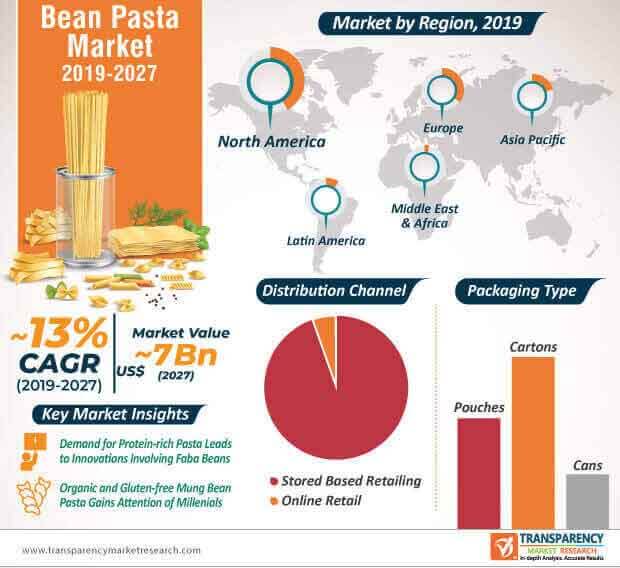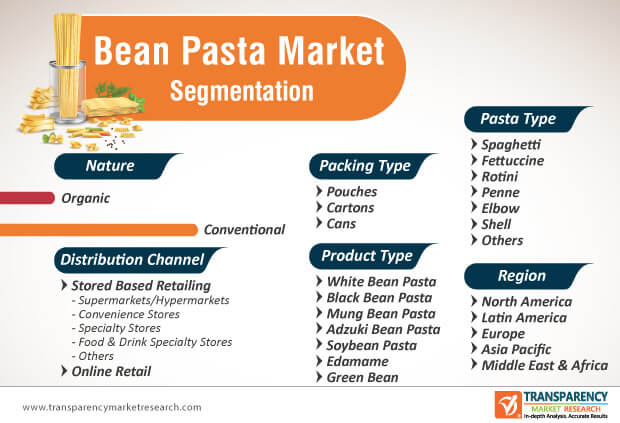Research in Structural Properties of Proteins Lead to Innovations in Bean Pasta
Protein-rich pasta is being highly publicized as a healthy innovation in the bean pasta market. Hence, companies are innovating in peas and faba beans, owing to their health promoting dietary fibers. The growing interest in locally produced high-quality protein food is casting a spotlight on legumes, peas, and faba beans. For instance, researchers at the Swedish University of Agriculture and the University of Copenhagen are increasing their efficacy in R&D activities to decipher whether proteins and fibers of peas and faba beans can be isolated for the commercialization of pasta products. Such research studies are offering important insights to companies in the bean pasta market and are generating incremental opportunities for companies in the market landscape.
Companies in the market for bean pasta should collaborate with researchers to understand how proteins and fibers of beans interact when heated at high temperatures. They are also increasing research to understand structural and mechanical properties such as chewing strength to make fresh pasta-like products with desirable and palatable characteristics.

Request a sample to get extensive insights into the Bean Pasta Market
Plant-based and Gluten-free Proteins Generate Value-grab Opportunities for Manufacturers
Millennials and generation Z are sharing an increased curiosity for ‘special’ pasta. This drive for experimentation is being capitalized by manufacturers in the bean pasta market where the market is projected to reach a value of ~US$ 7.3 Bn by the end of 2029. Hence, manufacturers are increasing the availability of organic green mung bean pasta, since the revenue of this pasta is anticipated for exponential growth during the forecast period. Manufacturers are increasing their focus in legumes as the flour of legumes complement with the dough during the pasta-making process.
Key drivers contributing toward market growth is the awareness about gluten-free and vegan pasta. Hence, the dining department at the University of Connecticut is introducing a new line of healthy & lean bean pasta dishes that are vegetarian, gluten-free, and low on carbs. Companies in the bean pasta market are tapping value-grab opportunities with increasing trends of plant-based proteins that are replacing animal proteins in pasta dishes.
To understand how our report can bring difference to your business strategy, Ask for a brochure
Is Bean Pasta Actually Worth Making a Choice?
More number of consumers are opting for new varieties of vegetable and bean pasta. Such trends are contributing toward the continuous growth of the bean pasta market, which is expanding at the hands of local and regional players accounting for a market share of ~78%-84%. Bean and vegetable pasta are becoming increasingly commonplace, owing to their attributes of high fiber and protein properties. However, bean pastas made from a mix of refined flour are not any different from the conventional white pasta alternatives. Such production practices might hamper market growth. Hence, manufacturers are developing pastas made from 100 percent bean flour to reassure the faith of pro-health consumers.
REQUEST FOR COVID19 IMPACT ANALYSIS –
https://www.transparencymarketresearch.com/sample/sample.php?flag=covid19&rep_id=48060
Companies in the bean pasta market are emphasizing on reading the ingredients on label to help consumers make informed decisions. They are marketing the advantages of bean pasta as an alternative to traditional flour pasta, owing to its high protein and fiber content.
Companies Expand Product Portfolio by Introducing New White Bean Pasta
Consumers are adding more plant-based proteins to their diets. This trend is being capitalized by companies in the bean pasta market who are increasing their production capabilities to produce white bean pasta. For instance, the U.S. food company Kraft Heinz added Kraft Macaroni & Cheese Dinner White Bean pasta to expand their product portfolio. This explains why the revenue of white bean pasta is anticipated to attain the second-highest revenue among product types in the bean pasta market.
White bean pasta is gaining popularity in the bean pasta market, owing to its high protein content. Beans, peas, and other legumes are some of the unsung champions of plant-based proteins. Companies such as Modern Table and Ancient Harvest are innovating in dried pasta noodles made from a variety of protein-dense and gluten-free beans as a suitable alternative to conventional wheat pasta.

Stuck in a neck-to-neck competition with other brands? Request a custom report on Bean Pasta Market
Analysts’ Viewpoint
The bean pasta market is progressing at a striking CAGR of ~12.9% during the forecast period. Pro-health consumers are benefitting with the introduction of bean pasta that replace unrefined/white-flour carbs with high protein and high fiber properties. Consumers are opting for healthier food choices by preferring to buy non-GMO pasta products.
The growing awareness about weight loss diets is encouraging consumers to prepare recipes made with half whole-wheat pasta and half vegetable or bean pasta to meet low carb requirements. However, most carbs in traditional white flour pasta is digestible starch, which serves the needs of athletes and cyclists. Hence, companies should strategically target bean pasta for consumers that take keen interest in connective tissue repair and immune system maintenance.
The Link LonkJanuary 19, 2021 at 02:32PM
https://ift.tt/3qAh1BK
Bean Pasta Market to rise at a CAGR of ~12.9% - KSU | The Sentinel Newspaper
https://ift.tt/31oM9uv
Pasta
No comments:
Post a Comment